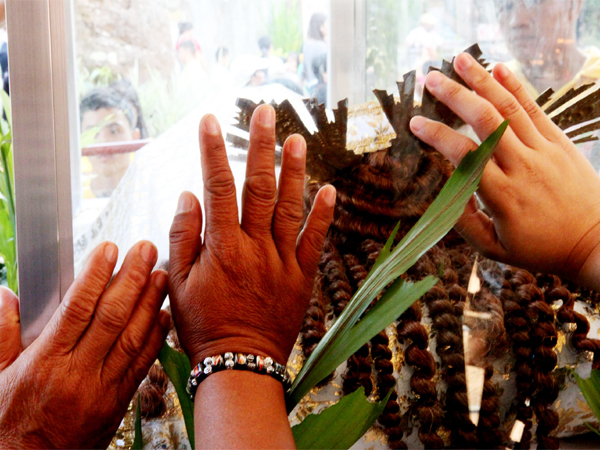Security tightened at pilgrim sites in Quezon and Albay

Devotees at the Kamay Ni Hesus Shrine in Lucban, Quezon on Good Friday in April 2012 touch the glass coffin of Santo Señor Sepulcro (The Dead Christ) and recite prayers for atonement of sins and request for favors. (File photo by DELFIN T.MALLARI JR. / Inquirer Southern Luzon)
Local police and augmentation forces from the regional police headquarters and Army soldiers have been deployed as of Wednesday to ensure the safety and security of hundreds of tourists and pilgrims expected to flock to the different religious sites in Quezon and Albay provinces from Maundy Thursday to Easter Sunday.
In Lucban, Quezon, Chief Insp. Alejandro Onquit, the town’s police chief, said they were expecting “continuous arrival of people from sunrise until evening on Maundy Thursday until Easter Sunday.”
Thousands of devotees, local and foreign, flock to this town every Good Friday to join a procession called “Santo Señor Sepulcro,” featuring the image of a dead Christ.
The procession – the most anticipated Holy Week event in Lucban – replicate the same kind of spiritual chaos that draws millions to Quiapo, Manila for the Black Nazarene feast.
Also located in the same town is the 5-hectare Kamay ni Hesus (KNH) Shrine, ready to welcome throngs of devotees and pilgrims for this year’s Lenten season.
Article continues after this advertisementThe KNH shrine has become one of the most popular Lenten destinations in the country, with visitors reaching millions during the Holy Week.
Article continues after this advertisementOnquit advised pilgrims and local and international tourists not to bring too many valuables and avoid showing ritzy gadgets and jewelry in public.
“They only attract too much attention from criminal elements in their midst which could also endanger their lives. And also keep watch of young children,” Onquit said.
He also appealed to the visitors to obey the traffic laws and regulations particularly the parking of vehicles in designated areas.
In Albay, Supt. Lawrence Bacia, Ligao City police chief, said they had deployed at least 45 police officers, with additional officers from the provincial police, to Kawa-Kawa Hill and Natural Park in Barangay Tuburan, Ligao City, for the safety of pilgrims and ensure a smooth flow of traffic in the area and those surrounding it.
Millions of tourists and pilgrims were expected to flock to the hill, as it is now considered a pilgrim site in the province.
Kawa-kawa was named after the hill’s cauldron-shaped summit that made it known as “the hill without a hilltop.”
The faithful visit the hill for its life-size sculptures depicting the 14 Stations of the Cross.
For several years now, the hill served as venue of the yearly diocesan youth Way of the Cross attended by pilgrims from different parishes in Albay.
Bishop Joel Baylon of the Diocese Legazpi, said “the unceasing coming of tourists originating from other places during Holy Week in order to pray and do the stations of the cross makes it a pilgrim site.”
To make the Lenten season meaningful, Baylon encouraged people to find time to meditate on the passion, death and resurrection of the Lord; turn away from worldly comforts; and seek reconciliation with God and with those whom they had offended. /atm